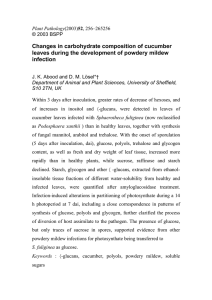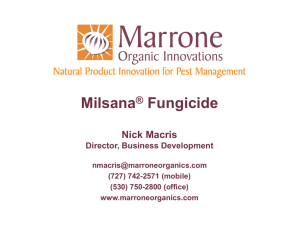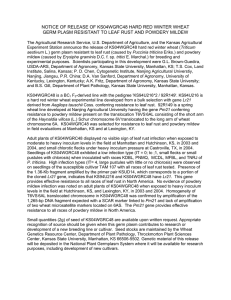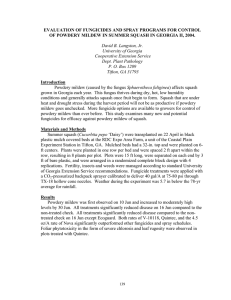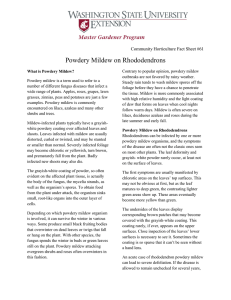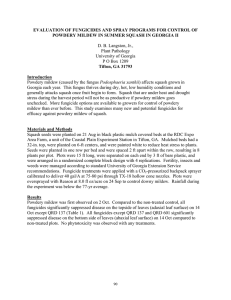Disease Resistant Annuals and Perennials in
advertisement
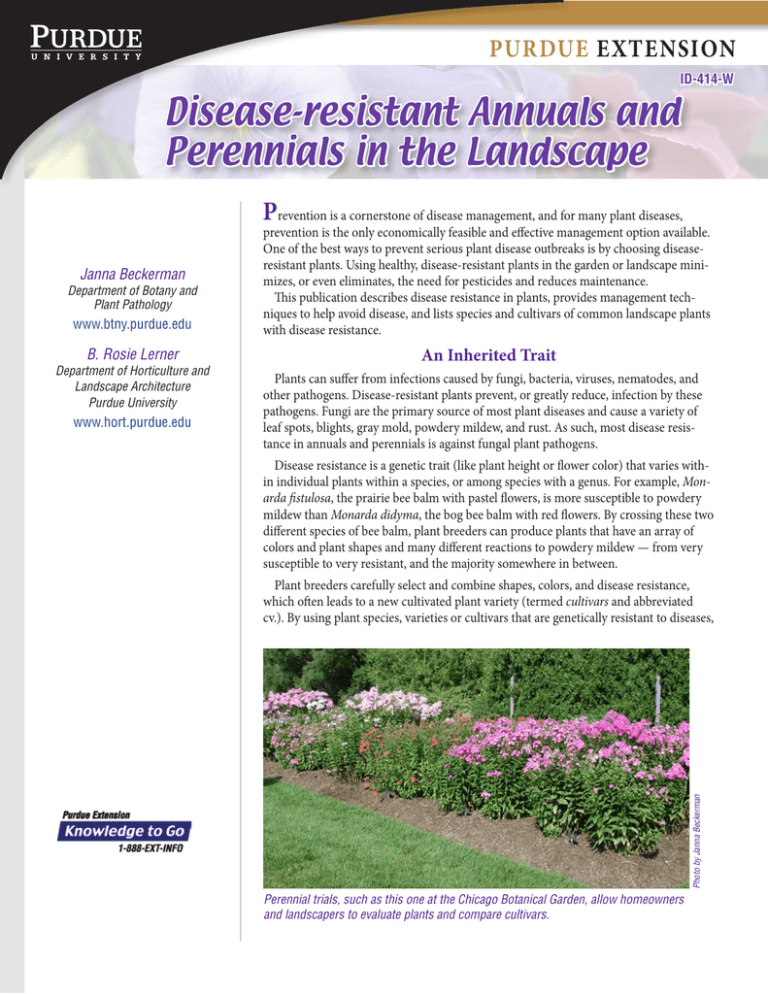
Purdue Extension ID-414-W Disease-resistant Annuals and Perennials in the Landscape Prevention is a cornerstone of disease management, and for many plant diseases, Janna Beckerman Department of Botany and Plant Pathology www.btny.purdue.edu prevention is the only economically feasible and effective management option available. One of the best ways to prevent serious plant disease outbreaks is by choosing diseaseresistant plants. Using healthy, disease-resistant plants in the garden or landscape minimizes, or even eliminates, the need for pesticides and reduces maintenance. This publication describes disease resistance in plants, provides management techniques to help avoid disease, and lists species and cultivars of common landscape plants with disease resistance. An Inherited Trait B. Rosie Lerner www.hort.purdue.edu Plants can suffer from infections caused by fungi, bacteria, viruses, nematodes, and other pathogens. Disease-resistant plants prevent, or greatly reduce, infection by these pathogens. Fungi are the primary source of most plant diseases and cause a variety of leaf spots, blights, gray mold, powdery mildew, and rust. As such, most disease resistance in annuals and perennials is against fungal plant pathogens. Disease resistance is a genetic trait (like plant height or flower color) that varies within individual plants within a species, or among species with a genus. For example, Monarda fistulosa, the prairie bee balm with pastel flowers, is more susceptible to powdery mildew than Monarda didyma, the bog bee balm with red flowers. By crossing these two different species of bee balm, plant breeders can produce plants that have an array of colors and plant shapes and many different reactions to powdery mildew — from very susceptible to very resistant, and the majority somewhere in between. Plant breeders carefully select and combine shapes, colors, and disease resistance, which often leads to a new cultivated plant variety (termed cultivars and abbreviated cv.). By using plant species, varieties or cultivars that are genetically resistant to diseases, Photo by Janna Beckerman Department of Horticulture and Landscape Architecture Purdue University Perennial trials, such as this one at the Chicago Botanical Garden, allow homeowners and landscapers to evaluate plants and compare cultivars. 1 Disease-resistant Annuals and Perennials in the Landscape ID-414-W Purdue Extension Photos by Janna Beckerman One of these techniques is choosing the appropriate location for plants. For example, sun-loving plants should be placed so they receive six or more hours of sun. Shade-loving plants should be located away from direct sun to prevent scorch or burning. Most common annual and perennial plants perform best when placed in full sun, although notable exceptions (such as part-sun and shade-loving plants such as Hosta, Coleus, Heuchera, and Begonia) highlight the importance of matching the plant to the site. Phlox ‘David’ (left), a Perennial Plant Association Plant of the Year, has good resistance to powdery mildew, unlike other phlox. buyers immediately implement the most effective and sustainable means of plant disease control in the landscape. Although most plants do not have resistance to many common diseases, incorporating disease-resistant plants in the landscape whenever possible minimizes the impact of certain diseases in the home landscape and potentially reduces pesticide use. Another technique to mininize the risk and severity of disease is avoiding conditions that induce stress. For example, providing too much or too little water, damaging the roots, and using plants that are not reliably hardy for a given climate, can stress plants and weaken their performance. Another practice is to increase air circulation around plants by allowing adequate spacing between plants, which allows foliage to dry quickly. Most fungal leaf diseases are favored by prolonged periods of leaf wetness; proper plant spacing information is often provided on plant labels and in many gardening texts. Finally, all plants should be watered at the base of the plant with care to avoid wetting the foliage. This reduces both the moisture and humidity fungal spores need to germinate and spread, thereby reducing disease. The perennials and annuals in the tables on the next two pages were evaluated as resistant in disease in trials throughout the United States. Due to regional variability in weather conditions and pathogen populations, these cultivars are only suggested for use, but have been observed to provide excellent results in the Midwest. To date, most disease resistance in commercially propagated nursery and greenhouse stock is traditionally bred into plants with other outstanding horticultural features. Occasionally, new disease-resistant plants are discovered, rather than bred, by observant horticulturists, as was the case for Phlox ‘David,’ a mildew-resistant phlox, and Perennial Plant of the Year in 2002. Using Disease Resistance Photos by Janna Beckerman The fungi that cause powdery mildew regularly infect zinnia, phlox, and bee balm each summer. Avoiding this disease in the Midwest is all but impossible. However, carefully incorporating powdery mildew-resistant plants such as phlox ‘David,’ bee balm ‘Jacob Cline,’ and zinnia ‘State Fair’ reduces the severity of powdery mildew on these plants, improves landscape appearance, and reduces the need for fungicides. It is important to note that the term disease resistance does not mean that the plant is completely immune to disease but instead refers to a plant’s ability to minimize infection by the pathogen. Unfortunately, no cultivar is resistant to all diseases. Management Techniques that Prevent Disease (Left) Common hollyhock is very susceptible to rust. Other members of the mallow family are less susceptible, such as checkerbloom (Sidalcea). In addition to disease resistance, it is important to remember that proper cultural techniques will help prevent powdery mildew, rust, and leaf spots. 2 Disease-resistant Annuals and Perennials in the Landscape ID-414-W Purdue Extension Disease-Resistant Perennials Host (Latin Name) Disease Resistance Species and Cultivars with Noted Resistance aster (Aster) rust New England Aster (A. nova-angliae): Crimson Beauty, Fanny’s, Harrington’s Pink, Honeysong Pink, Purple Dome, Wedding Lace Wood Aster (A. dumosus): Wood’s Blue bee balm (Monarda spp. and hybrids) powdery mildew and rust Blaukranz, Colrain Red, Jacob Cline, Marshall’s Delight, Petite Delight, Gardenview Scarlet Fusarium wilt Achievement, Copper Bowl, Escapade, Helen Castle, Mandalay, Matador, Miss Atlanta, Orange Bowl, Powder Puff Verticillium wilt Avoid highly susceptible cultivars such as Bravo, Illini Trophy, Orange Bowl, Royal Trophy, and Yellow Delaware. garden mum and Shasta daisy (Chrysanthemum, Dendranthemum and Leucathemum spp. and hybrids) Avoid susceptible cultivars such as Bright Golden Ann, Echo, Glowing Mandalay, Mountain Peak, Paragon, Pert, Puritan, and Wedgewood Blue Bird, Blue Lace, Cameliard, Galahad, King Arthur, New Zealand series, Belladonna types (shorter, bushier delphiniums), Butterfly Blue, Volkerfrieden rust delphinium powdery mildew geranium powdery mildew Alan Bloom, Buxton’s Blue, Biokovo, G. dalmanicum, G. album hollyhock, checkerblooms, mallows, and other Malvaceae (Alcea, Sidalcea, Malva) hollyhock rust Alcea ficifolia, Happy Lights, Russian hollyhock (Alcea rugosa), Sidalcea (all varieties), Malva (all cultivars) peony (P. suffructicosa, P. lactiflora) Botrytis blight Garden peony (P. lactiflora): America, Buckeye Belle, Krinkled White, Old Faithful, Pink Hawaiian Coral, Roselette, Scarlet O’Hara, White Cap Tree peony (Paeonia suffruticosa), ‘Itoh Hybrids’ (P. suffructicosa x P. lactiflora), and other intersectional hybrids are generally more resistant to botrytis blight and peony measles than P. lactiflora (garden peony): Bartzella, Gold Crown, Rozella phlox (Phlox panniculata, P. maculata) powdery mildew Alpha, David, Pastel Dream, Frosted Elegance, Laura, Miss Lingard, Norah Leigh, Robert Poore, Shortwood, David’s Lavender lungwort (Pulmonaria spp.) powdery mildew Spilled Milk, Benediction, Glacier, Little Star, Merlin, Excaliber, P. rubra Redstart, David Ward powdery mildew Annual Rudbeckia Tiger Eye Gold leaf spot Avoid R. Goldsturm and Black Beauty, both of which appear uniquely susceptible to certain leaf spots powdery mildew May Night (Mainacht), East Friesland, Blue Queen, Rose Queen, Blue Hill, Snow Hill, S. nemerosa Caradonna, Silver Sage (Salvia argentea) powdery mildew Most sedums possess good disease resistance; however, S. ‘Matrona’ is especially susceptible powdery mildew and should be avoided powdery mildew Icicle, Crater Lake Blue, Sightseeing, V. schmidtiana black-eyed Susan (Rudbeckia spp.) sage or salvia (Salvia spp.) sedum (Sedum spp.) speedwell or Veronica (Veronica spp.) Disease-Resistant Annuals Host (Latin Name) Disease Resistance Species and Cultivars with Noted Resistance annual geranium (Pelargonium spp.) bacterial leaf spot and stem rot Lady Washington and Martha Washington (P. domesticum), Madame Layal and Marie Vogel (P. x domesticum), Torento, Peppermint (P. tomentosum), Countess of Scarborough (P. scarboroviae) begonia (Begonia spp.) bacterial leaf spot and blight Rex and tuberous begonias are less severely infected than Rieger begonias. The least susceptible Rex include Duarten, Helen Teupel, Marion Louise, Pauline, Peace, Red Dot, Vesuvius annual vinca, periwinkle (Catharanthus ) Phytophthora aerial blight Cora and Nirvana series, Little Bright Eye, Little Linda, Little Pinkie 3 Disease-resistant Annuals and Perennials in the Landscape Purdue Extension ID-414-W Host (Latin Name) Disease Resistance Species and Cultivars with Noted Resistance marigold (Tagetes spp.) Alternaria leaf spot Golden Guardian, Doubloon pansy (Viola spp. and hybrids) Cercospora leaf spot Bingo Red & Yellow, Crown Blue, Crown Golden, Crystal Bowl Supreme Yellow, Crystal Bowl True Blue, Dynamite Red & Yellow, Majestic Giants Yellow, Sorbet Blackberry Cream Pansy Patiola series cultivars (Purple Passion, Pu Yellow, Pu Lemon, Pu Orange) were less susceptible to leaf spot than Colossus series cultivars petunia (Petunia spp.) botrytis flower blight Fantasy Blue, Tidal Wave Hot Pink annual phlox (P. drummondii) powdery mildew Most annual phlox are powdery mildew resistant snapdragon (Antirrhinum spp. and hybrids) rust Few verified reports. Wisley Golden Fleece, White Monarch, and Orange Glow are resistant to most forms of the fungus Other reportedly resistant cultivars include the Rocket series and Amalia series verbena (Verbena spp. and hybrids) powdery mildew Verbena Aztec Violet, Laskar Light Pink, Empress Strawberry, Tukana Deep RedBurgundy, Dark Blue Lascar White, Rapunzel Lilac, Aztec Dark Red, Coral, Pink Shades zinnia (Zinnia spp. and hybrids) powdery mildew Oklahoma, Profusion, Crystal White, Ruffles, Panorama Red, State Fair References Holcomb, G. E. and P. Cox. 2003. ”Petunia: Petunia x hybrida Flower spot/blight: Botrytis cinerea. Reaction of petunia cultivars to Botrytis flower spot and blight, 2002.” Plant Disease Management Reports 18:O009. Aitken, E. A. B., H. J. Newbury, and J. A. Callow. 1989. “Races of rust (Puccinia antirrhini) of Antirrhinum majus and the inheritance of host resistance.” Plant Pathology 38:169-175. Chase, A. R. 1992. “Resistance of some Rex begonia cultivars to Xanthomonas campestris pv. begoniae.” CFREC-Apopka Research Report RH-92-18. University of Florida. Hagan, A. 2006. “Reaction of African and French Dwarf marigold cultivars to Alternaria leaf spot, 2005.” Plant Disease Management Reports 1:OT012. Daughtrey, M. and M. Tobiaz. 2007. “Comparison of verbena cultivars for susceptibility to powdery mildew, 2007.” Plant Disease Management Reports 2:OT013. Hagan A. K., M.E. Rivas-Davila, and J.R. Akridge. 2003. “Pansy: Viola x wittrockiana Cercospora leaf spot: Cercospora viola Reaction of pansy and viola selections to Cercospora leaf spot, 2002.” Plant Disease Management Reports 18:O003. Dreistadt, S.H. 2001. Integrated Pest Management for Floriculture and Nurseries. University of California Division of Agriculture and Natural Resources. Publication 3402. Reference to products in this publication is not intended to be an endorsement to the exclusion of others that may be similar. Persons using such products assume responsibility for their use in accordance with current directions of the manufacturer. Purdue Agriculture NEW 8/09 It is the policy of the Purdue University Cooperative Extension Service that all persons have equal opportunity and access to its educational programs, services, activities, and facilities without regard to race, religion, color, sex, age, national origin or ancestry, marital status, parental status, sexual orientation, disability or status as a veteran. Purdue University is an Affirmative Action institution. This material may be available in alternative formats. Order or download materials at the Purdue Extension Education Store • www.extension.purdue.edu/store 4


